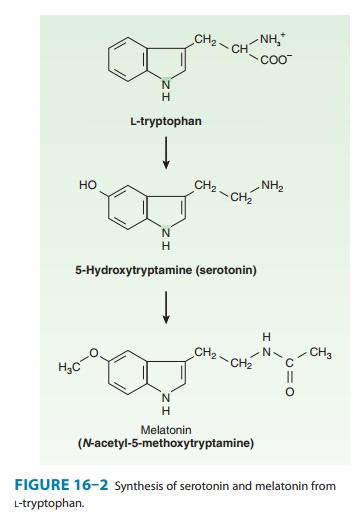Chapter: Basic & Clinical Pharmacology : Histamine, Serotonin, & the Ergot Alkaloids
Melatonin Pharmacology
Melatonin Pharmacology
Melatonin is N-acetyl-5-methoxytryptamine (Figure 16–2), a simple methoxylated and N-acetylated product of serotonin found in the pineal gland. It is produced and released primarily at night and has long been suspected of playing a role in diurnal cycles of animals and the sleep-wake behavior of humans. Melatonin receptors have been characterized in the central ner-vous system and several peripheral tissues. In the brain, MT1 and MT2 receptors are found in membranes of neurons in the supra-chiasmatic nucleus of the hypothalamus, an area associated— from lesioning experiments—with circadian rhythm. MT1 and MT2 are seven-transmembrane Gi protein-coupled receptors. The result of receptor binding is inhibition of adenylyl cyclase. A third receptor, MT3, is an enzyme; binding to this site has a poorly defined physiologic role, possibly related to intraocular pressure. Activation of the MT1 receptor results in sleepiness, whereas the MT2 receptor may be related to the light-dark synchronization of the biologic circadian clock. Melatonin has also been implicated in energy metabolism and obesity, and administration of the agent reduces body weight in certain animal models. However, its role in these processes is poorly understood and there is noevidence that melatonin itself is of any value in obesity in humans. Other studies suggest that melatonin has antiapoptotic effects in experimental models. Recent research implicates melatonin receptors in depressive disorders.

Melatonin is promoted commercially as a sleep aid by thefood supplement industry . There is an extensive literature supporting its use in ameliorating jet lag. It is used in oral doses of 0.5–5 mg, usually administered at the destination bedtime. Ramelteon is a selective MT1 and MT2 agonist that is approved for the medical treatment of insomnia. This drug has no addiction liability (it is not a controlled substance), and it appears to be distinctly more efficacious than melatonin (but less efficacious than benzodiazepines) as a hypnotic. It is metab-olized by P450 enzymes and should not be used in individuals taking CYP1A2 inhibitors. It has a half-life of 1–3 hours and an active metabolite with a half-life of up to 5 hours. The toxicity of ramelteon is as yet poorly defined, but prolactin levels were elevated in one clinical trial. Agomelatine, an MT1 and MT2 ago-nist and a 5-HT2C antagonist, has recently been approved in Europe for use in major depressive disorder.
Related Topics